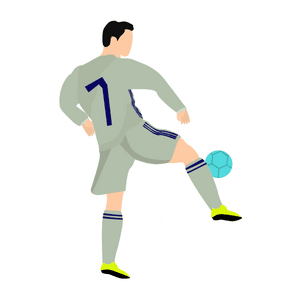What Does CDM Mean in Soccer?
What does a CDM mean in soccer? A CDM stands for ‘central defensive midfielder’ and is a hybrid of a defender and midfielder.
For those unfamiliar with soccer, the terminology used to describe player positioning might seem complicated. There are many different phrases and acronyms describing what various players do in different parts of the field.
At SoccerNovo, we’re here to educate and inform our loyal visitors about the game of soccer. Different soccer positions are just as important as the rules!
With that out of the way, let’s get down to the topic of today’s article, which will examine the definition and function of the term “CDM” in soccer.
What Does CDM Stand For?
‘CDM’ stands for Central Defensive Midfielder when referring to soccer. This player operates as a midfielder and defender.

Although this player’s primary role is usually more on the defensive side, he or she is also capable of making runs, passing the ball ahead, and trailing for a shot on goal.
Overall, a solid CDM is strong with the ball, tough on defense, anticipates well, passes effectively, and has developed a high soccer IQ.
What Is the Role of a CDM?
Central defensive midfielders are often more cautious and defensive in their approach to the game. Unlike central attacking midfielders or wingers, they aren’t typically tasked with rushing into the opposing team’s territory as often.
Instead, they are tasked with defending the defense through strategic positioning, which may involve:
- Eliminating passing lanes
- Break the opposition’s attack
- Having a solid commitment to blocking and tackling
- Covering ground when midfielders are beat
- Start a counter attack out of the backfield
They play a very important role on a team where they are asked to defend and distribute through the center of the field.
What Makes a Great CDM?
There are many soccer qualities that make a great CDM, they include:
- Reading The Game – The finest CDMs have the uncanny ability to be in the right location at the right time, even before the threat eventuates.
- Controlled Aggression – This crucial quality centers on the term “controlled” since a CDM is often one of the game’s strongest players and finds themselves in opportunities to make defensive plays.
- Work Rate – Defensive midfielders in the middle of the field are always on the move and have to be at the forefront of every action.
- Tackling – Being an effective on-ball tackler is quickly becoming a forgotten art as today’s elite teams look for players with more skill and delicacy around the goal.
- Communication – A central defensive midfielder must be able to lead both midfield and defense at the same time since they are the glue between defense and offense and the first line of defense.
- Composure – The greatest CDMs remain calm and collected under fire, causing their opponents to lose their composure and make careless plays.
- Strength – Defensemen rely heavily on their upper and lower body strength to shield and make proper tackles.
Styles of Defensive Midfielder
A defensive midfielder’s role could slightly change depending on the coach’s game formations and tactics. Here are some variations of defensive midfielders.
Defensive Midfielder
Their primary responsibility is to disrupt the other team’s play. They put faith in their natural ability to make defensive plays happen. These players take full responsibility when things go good and bad. They usually have a strong character and will their team to succeed.
Players in this position don’t have to be the biggest as long as they are able to disrupt momentum.
Holding Midfielder
These players are more technically proficient defensive midfielders whose main role leans more towards attacking. They usually have the green light to cover more of the field when appropriate.
Holding midfielders mostly “keep” their place in front of the defense and anticipate well when necessary to neutralize threats from the other team.
Hybrid
A hybrid defensive midfielder is fluid in game situations. For example, if their team is winning, they may tend to gravitate more toward a true defensive midfielder.
They have strong technical and physical skills of a Defensive Midfielder but may lack the size of other defenders. Because of this, we may classify them as a hybrid of defensive and holding midfielders.
What Jersey Numbers Do CDMs Wear?
The central defensive midfielder position is usually wearing the number 5 or 6 on the back of their uniform. This is sometimes interchangeable with the center-back position which typically wears 4 or 5.
It’s important to note that the numbers worn by players are not set in stone and can vary depending on the team and coach’s preferences, and sometimes players may wear different numbers throughout their career.
Famous Central Defensive Midfielders
These CDM’s have made a name for themselves over the years and some continue to impact the game.
- Marco Verratti
- Kevin De Bruyne
- Jorginho
- Marcos Llorente
- N’Golo Kante
- Ilkay Gundogan
- Yves Bissouma
- Frenkie de Jong
- Emerson Royal
Conclusion
A central defensive midfielder (CDM) is essential to a soccer team. The player must have strong tackling and defensive skills, as well as the ability to anticipate passes to open up scoring opportunities for their teammates.
By constantly monitoring the positions of the other team’s players, a competent CDM may help his team retain control of the ball and avoid losing it to the opposition.
They must also have excellent peripheral vision to keep track of the action at all times, including keeping an eye on the opponent’s midfielders to anticipate through-balls and the like.
By understanding the role and responsibilities of this position, a CDM should be an important part of any soccer team.
Like every other position in soccer, it will take time to practice and get familiar with the style and angles necessary to be effective.
But, the role is an important one and reserved for some of the best and strongest players!
Frequently Asked Questions
CDM stands for ‘Central Defensive Midfielder’ in soccer.
The CDM or Central Defensive Midfielder is a position on the field that is responsible for defending the team’s own goal and disrupting the opposing team’s attacks. The CDM typically plays in front of the team’s defense, and is often tasked with breaking up opposing attacks, intercepting passes, and making tackles. Additionally, the CDM may also be responsible for distributing the ball to the team’s attacking players and initiating counterattacks.

Written By: SoccerNovo
SoccerNovo is an independent youth soccer media brand built to help parents, players, and coaches better understand the game and the pathways available in U.S. soccer. Our mission is to make youth soccer simpler, clearer, and more accessible for everyone involved in it.
Let’s connect





